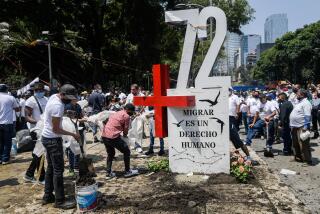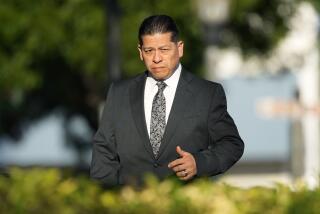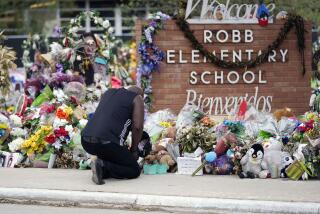A Mexican police chief is finally arrested in the disappearance of 43 students. But will he talk?
- Share via
Reporting from Mexico City — Mexican authorities said they hope the arrest of a former police chief who had been a fugitive for more than two years will help them solve one of the country’s most notorious human rights cases: the disappearance and presumed murder of 43 students.
Felipe Flores Velazquez, 58, was arrested Friday without incident in Iguala, the town in Guerrero state where the students were last reported alive in September 2014. At the time, he was the police chief there.
Renato Sales Heredia, head of the National Security Commission, said at a news conference Friday in Mexico City that Flores was detained after visiting his wife in Iguala.
He is being held on suspicion of organized crime and kidnapping, Sales said. “The investigations indicate that this person was one of those responsible with coordinating the operation that turned into aggression against the students,” he said.
In a Twitter message, Mexican Atty. Gen. Arely Gomez said the arrest and the prospect of testimony from the ex-chief should help “clarify the facts of Iguala.”
Flores’ arrest adds to a growing roster of detentions in a case that has become an extreme embarrassment for the administration of President Enrique Peña Nieto.
Officials say they have arrested 131 people in connection with the mass disappearance, mostly local police and suspected drug gang members. The former mayor of Iguala and his wife are also among those detained. Some detainees have alleged torture by Mexican authorities.
Still, despite all the arrests, court cases, testimony and publicity surrounding the case, there is still no definitive answer as to what happened to the students on that evening. Many in Mexico fear that their precise fate will never be known.
The students, from a teachers’ school in the rural town of Ayotzinapa, had hijacked several buses and were planning to join a protest. But they were detained by police in Iguala on the evening of Sept. 26, 2014. They have not been seen since.
Not long after the students disappeared, so did the police chief. He was long seen as a key figure in piecing together what happened.
Various theories have surfaced, some contradictory.
Mexican authorities have said the students were picked up by police and handed over to a drug gang, which executed them and set their remains ablaze.
But families of the students, forensic experts, an international investigative commission and others have questioned the official findings. The bodies have never been found.
While the federal government has repeatedly denied any cover-up, the case has come to symbolize a corrupt system in which criminals and cops work hand in hand.
Cooperation between local police and drug traffickers and other organized crime groups has been documented in Guerrero state and elsewhere in Mexico.
Cecilia Sanchez in The Times’ Mexico City bureau contributed to this report.
ALSO
U.S. service member killed by bomb blast in northern Iraq
Inside the underground hide-out of an Islamic State leader
UPDATES:
5:25 p.m.: This article was updated throughout with details of the arrest and background on the killings.
This article was originally published at 2:30 p.m.
More to Read
Sign up for Essential California
The most important California stories and recommendations in your inbox every morning.
You may occasionally receive promotional content from the Los Angeles Times.










